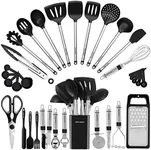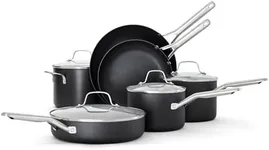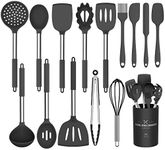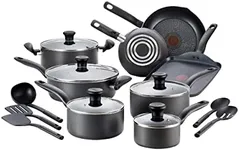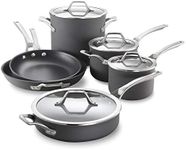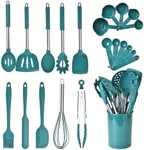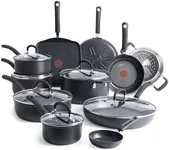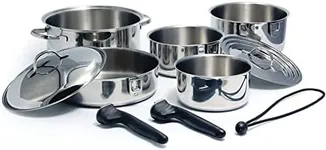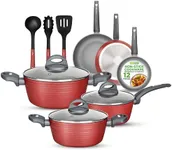Buying Guide for the Best Non Stick Utensil Set
Choosing the right non-stick utensil set can make your cooking experience much more enjoyable and efficient. Non-stick utensils are designed to be used with non-stick cookware to prevent scratching and to ensure that your pots and pans last longer. When selecting a non-stick utensil set, it's important to consider several key specifications to ensure that the set meets your cooking needs and preferences. Here are some important factors to consider when making your choice.MaterialThe material of the utensils is crucial because it affects durability, heat resistance, and how well it works with non-stick cookware. Common materials include silicone, nylon, and wood. Silicone is highly heat-resistant and flexible, making it great for a variety of cooking tasks. Nylon is also heat-resistant and tends to be more rigid, which can be useful for certain types of cooking. Wood is gentle on non-stick surfaces but can be harder to clean and may not be as durable. Choose the material based on your cooking habits and the types of dishes you prepare most often.
Heat ResistanceHeat resistance refers to the maximum temperature the utensils can withstand without melting or degrading. This is important to ensure that the utensils remain safe and functional during cooking. Silicone utensils typically have the highest heat resistance, often up to 450°F (232°C), while nylon utensils can usually withstand up to 400°F (204°C). Wooden utensils are naturally heat-resistant but can burn if left in contact with high heat for too long. Consider the types of cooking you do and choose utensils that can handle the temperatures you commonly use.
Number of PiecesThe number of pieces in a set determines how versatile and comprehensive the set is. Basic sets may include just a few essential pieces like a spatula, spoon, and ladle, while more comprehensive sets can include a variety of specialized tools like tongs, whisks, and pasta servers. Think about the types of dishes you cook and the tools you frequently use. If you do a lot of different types of cooking, a larger set with more specialized tools might be more useful.
ErgonomicsErgonomics refers to how comfortable and easy the utensils are to use. This includes the design of the handles, the weight of the utensils, and how they feel in your hand. Look for utensils with comfortable, non-slip handles that are easy to grip. The weight should be balanced so that the utensils are easy to maneuver. If possible, try holding the utensils before purchasing to ensure they feel comfortable and natural in your hand.
Ease of CleaningEase of cleaning is an important factor, especially if you cook frequently. Some materials, like silicone and nylon, are dishwasher safe, making cleanup quick and easy. Wooden utensils usually need to be hand-washed and dried immediately to prevent damage. Consider your cleaning preferences and choose utensils that fit your lifestyle. If you prefer low-maintenance options, look for dishwasher-safe utensils.
Compatibility with CookwareCompatibility with your cookware is essential to prevent damage to your pots and pans. Non-stick utensils are designed to be gentle on non-stick surfaces, but it's still important to ensure that the utensils you choose are suitable for your specific cookware. Check the manufacturer's recommendations for your cookware and choose utensils that are designed to be safe for use with non-stick surfaces.

